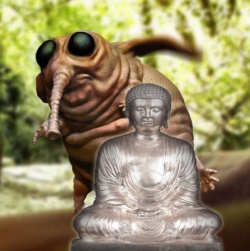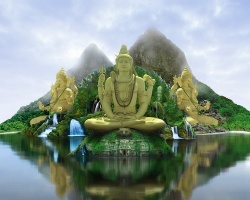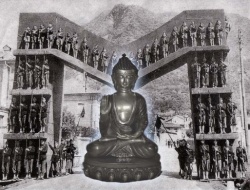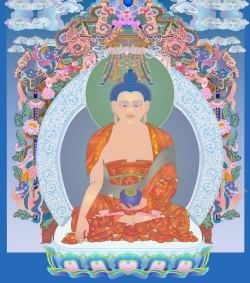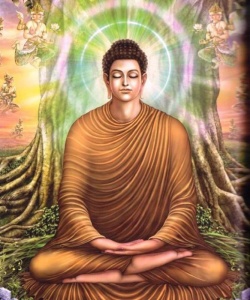The Significance of Nāgārjuna Śūnyatā Doctrine
by Jointu Chakma
Introduction:
Nāgārjuna is a great figure of Madhyamika school of Mahayana Buddhism who was lived between in the 1st and 2nd century CE.[1] He was born as a "Hindu," which in his time connoted religious allegiance to the Vedas, probably into an upper caste Brahmin family and probably in the southern Andhra region of India.[2] According to David J.Kalupahana, Nāgārjuna has been considered as the second Buddha and has occupied a second position in the line of patriarchs in almost all schools of Buddhism. Nāgārjuna represented an excellence doctrinal teaching against Śarvāstivādins and Puggalavādins dogmatic dharma-s doctrine which gained popularity among every society people. Nagarjuna wrote Fundamental Verses on the Middle Way (Mulamadhyamakakarika), by which after his passing away a school is emerged named as “Madhyamaka or Madhyamika” (middle-way). Nāgārjuna attempted to make understand about the world beyond neither believing on existence (atthita) nor non-existence (natthita) but everything is dependently co-arising (pratityasamutpāda) and empty of self-nature (svabhāva) of things. His doctrine of emptiness (Śūnyatā) rejects two extremes of existence and non-existence of things and follows middle way (madhyamapratipāda).
In this short writing I will briefly attempt to analyze the Śūnyatā (emptiness) doctrine of Nāgārjuna with comparison to early teaching of the Buddha. I have been attended that almost many of scholars roughly misunderstand the concept of emptiness as nihilistic doctrinal teaching. From my position I will summarize to make understand about the significance of Nāgārjuna Śūnyatā doctrine with historical background, why Nāgārjuna reinterpreted the doctrine of “Anatta” (no-self) and “Paticcasamuppada” (dependent co-arising) of the Buddha, is neither a doctrine of nihilism nor eternalism. The Śūnyatā doctrine of Nāgārjuna is the fundamental doctrine of the Buddha will be examined.
The meaning of the term “Śūnyatā”:
Śūnyatā is a Sanskrit term, which generally translated into English as ‘Emptiness’ or ‘Nothingness’ or ‘Voidness’, is a concept of central importance in the teaching of the Buddha.[3] In Pāli it is called Suññata which stands on the same meaning in English as ‘emptiness’ or ‘voidness’ and sometimes it has translated as un-substantiality, phenomenality, freedom from lust, ill-will and dullness.[4] The word Śūnyatā comes from adjective śūnya (in Sanskrit), suñña (in pāli), śūna (in vedic). These three words are translated as the same meaning of ‘empty’ or ‘void’.[5] Empty of something else or empty of permanent substance (svabhāva śūnya). Actually, this term “Śūnyatā” is the gradual development of Buddhist scholasticism.
In early Buddhist literatures “emptiness” (suññata) was described in the three perspectives, treating it
(1) as a meditative dwelling,
(2) as an attribute of objects, and
(3) as a type of awareness release.
For example, the Buddha at Samyutta Nikāya referring to ānāpānasati “mindfulness by in and out breathing” says:
“Monks, in this connection, a monk, going to the forest (araññagato) or going to the root of a tree (rukkha-mūlagato) or going to an empty place (suññagāra-gato), sitting cross-legged, holding the body straight, setting mindfulness in front of him, mindfully breathes out and in”.[6]
Again in the Saṃyutta Nikāya the Buddha explained about the notion of emptiness when Ananda asked to the Buddha in thus;
“Venerable Sir, it is said the world is empty, the world is empty. In what respect the world is empty?
The Buddha replied, “Insofar as it is empty of a self or of anything pertaining to a self (suññam idam attena vā attaniyena vā); thus it is said, Ananda, that the world is empty”.[7]
The Buddha clearly explained that the self is so-called world, and it pertain non-self. Nāgārjuna too, explained the meaning of Śūnyatā in this way, as he denies about the existence of intrinsic self-nature.
The Heart Sutra of Mahāyāna Buddhism declares that the skandhas, which constitute our mental and physical existence, are empty in their nature or essence, i.e., empty of any such nature or essence.
“Sariputra, the Characteristics of the emptiness of all dharmas are non-arising, non-ceasing, non-defiled, non-pure, non-increasing, non-decreasing."[8]
The word “Śūnyatā” has been interpreted and used for various purposes by the Buddha himself, and mainly in Nāgārjuna Śūnyatā doctrine it used to denote the empty of own self-nature (svalaksana).
The background of Nāgārjuna Śūnyatā doctrine:
The Śūnyatā (emptiness) doctrine of Nāgārjuna evolved during his life time, it is believed that he was a historical human being who lived sometime between 150 and 250 CE.[9] The main purpose of developing the Śūnyatā doctrine is due to Abhidharmikas interruption against the Buddha teaching.
Abhidharmikas developed a doctrine among many Buddhist schools that the all dharmas are exists in the three period of time. Therefore, Nāgārjuna invented the restatement of “anatta” doctrine and “paticcasamuppada” of the Buddha to answer the dharma-theory of Abhidharmikas.
There are several Abhidharmika schools by which majority of people were influenced, such as Sarvāstivādins, Vaibhāsikas, Sautrantikas and Vātsiputriya. Sarvāstivāda was the most influential abhidharma school at that time which had developed probably by the middle of the 3rd Century B.C.[10]
This school opposed to Vibhajyavādins, and claimed that “all exists (sarvam asti)” in the sense of this manner is: the past dharma-s have existed; the future dharma-s will come into existence; the present dharma-s are existing”.
[11] All dharma-s in phenomenal existence are pratītya-samutpanna—dependently originated from an assemblage of conditions. According to Sarvāstivādins a dharma insist within which had in the past, in the present and in the future is real existence. Sarvastivadins forwarded the theory of “self nature” (svabhāva) and Sautrantikas introduced their conception of self or person (ātman, pudgala).On the other hand, the Vaibhāṣika eventually came to connote the orthodox Sarvāstivādins.
The Vaibhāṣikas maintain that everything exist for ever (sarvaṃ sarvadā asti) it means that all dharmas exist in the three periods of time, and the emphasis put on the reality (svabhāva) of dharmas is indicative of the conception that not only their present, but their past as well as future transition, too, represent something real.[12] In the Abhidharmakośabhāṣya of Vasubandhu explains about the term “dharma” as follows:
“A dharma is so called because it sustains its own characteristics. This dharma faces (abhi) toward the dharma in the highest sense –Nirvāṇa, or toward the characteristics of dharma-s, thus it is abhidharma”.[13]
In the Abhidharma-mahā-vibhāṣa-śastra it is said that dharmas have own-self character which can not be separated, explained in thus; “The entity itself is [its] characteristic, and the characteristic is the entity itself; for it is the case for all dharma-s that the characteristic cannot be predicated apart from the dharma itself”.[14] Vātsīputrīyas ideas define those who had in believing a pudgala or existing person.[15] Sarvāstivādins and Pudgalavādins were connected.
The Pudgalavādins also had connection with Mahāsaṃgikas, i.e. Prajñaptivādins.[16] On contrary of the Abhidharma-schools, Nāgājuna gave the doctrine of “emptiness or empty of self-nature or empty of existing dharmas” by which he recounts the “anatta” doctrine of the Buddha. This is the main reason to maintain the Śūnyatā doctrine of Nāgārjuna against the dharma-theory of Abhidharmikas-schools.
Nāgārjuna “Śūnyatā” and the Buddha “Anatta” doctrine
In this sub-topic I would like to analyze with comparison between the doctrine of Nāgārjuna “Śūnyata” (emptiness) and the Buddha “Anattā” (no-self). The concept of Ātman[17] (universal self) was the foremost central philosophical problematic doctrine among 62 views[18] in India during the time of the Buddha. The concept of Ātman (universal self) is the essence of the human existence developed in the Upaniṣads.[19] They believed that the Ātman, the self which had to be a Self of some creature needed for itself a certain definiteness in this bond with certain substratum. In the same time they developed the idea of ego, of Self to Brahma as Supreme Being with the one name. Hermann Oldenberg described in his book about the concept of Ātman and Brahman in thus, “When they wanted to describe Ātman, they said it was Brahman. If one asked for the Brahman, they explained it as Ātman.”[20] But the Buddha rejected such kind of dogmatic doctrine and formed a new pragmatic doctrine whereas he asserted in detail about “Atta” (self) and “Anattā” (no-self) in his Anattalakkhana sutta of Samyutta Nikayā as follows:
“The body, monks, is not self….'Feeling is not self.... Perception is not self.... Mental processes are not self....Consciousness is not self…..”“Any feeling whatsoever....Any perception whatsoever....Any mental processes whatsoever....Any consciousness whatsoever past, future, or present; internal or external; blatant or subtle, common or sublime, far or near: every consciousness is to be seen as it actually is with right discernment as: "This is not mine. This is not my self. This is not what I am."[21]
Nāgārjuna in his position sees the dharmas from an entirely different angle. He reinterprets the causal law (pratītyasamutpāda) to mean relativity (Śūnyatā) and, on the basis of that interpretation, undertakes a through examination of the dharma-theory[22] of the Abhidharma-schools. He criticizes to Abhidharma-schools while examining the dharma-theory in relation to anātma-doctrine. He rejects both the substance view (ātma-vāda) and the modal view (dharma-vāda). If there is no self, how character of own nature (svabhāva) could be ultimate reality? In Mūlamadhyamakakārikā he examines in thus;
In the absence of a self, how can there be something that belongs to the self? From the appeasement of the modes of self and self-hood, one abstains from creating the notions of “mine” and “I” (ātmany asati cātmīyam kta eva bhavisyati, nirmamo nirahamkārah samād ātmātmani-nayoh). [23]
Thus, Nāgārjuna rejects the dharma-theory of the Abhidharma-schools alike the Buddha rejects the “soul-theory” (ātman) of Upanisadic religious doctrine. According to many Buddhist scholars, the theme of Śūnyatā emerged from the Buddhist doctrines of Anattā. Of course Nāgārjuna did not use “Śūnyatā” doctrine just only for reinterpreting “anattā” doctrine, but meaningfully he tried to make clear vision on Abhidharmikas dogmatic views and recounts the Buddha teaching that “all dharma-s are without a self” (sabbe dharma anattā ti). [24]
Then how something do exist if there is neither-nor, is a common question was asked by Abhidharmikas. Nāgārjuna answered it by analyzing casual-law (pratityasamutpāda).
Nāgārjuna Śūnyatā and Pratityasamutpāda:
The Buddhist doctrine of Interdependent Origination implying as it does from the Madhyamaka standpoint, the continuity of cause (hetu) and effect (phala), the avoidance of alternative views and ultimately Emptiness (śūnyata). Madhyamaka is not nihilism (nāstivāda), but a clarification of dependent co-arising. Nāgārjuna reclaimed the doctrine of dependent co-arising as a doctrine of emptiness. The Buddha's teaching called Paticca-samuppada, usually translated as Dependent Origination, is fundamental to the Dhammā (Truth) awakened to by The Buddha on the night of His Enlightenment. The Buddha said:
“One who sees the dependent origination (pratityasamutpāda) sees the Dhammā; one who sees the Dhammā sees dependent origination”.[25]
Here Dhammā (in the plural) meaning phenomena or things.[26] According to David J.Kalupahana, these are dependently arisen phenomena referred to earlier. They may also be described as elements of experience. Nāgārjuna in Mūlamadhyamakakārikā said:
“One who sees all things as arising in dependence, sees unregenerate existence and its origin, its cessation and the path to its cessation as they truly are.”[27]
The dependent origination describes the dependence of all phenomena upon cause (hetu) and condition (pratyaya), thus:
“When this exists, that comes to be; with the arising of this, that arises. When this doest not exist, that does not come to be; with the cessation of this, that ceases” (Imasmim sati idam hoti, imassa upādā idam uppajjati. Imasmim asati idam na hoti, imassa nirodha idam nirujjhati).[28]
Nāgārjuna wrote in the causality verses of Mūlamadhyamakakārikā in thus:
“Nothing whatever arises. Not from itself, not from another, not from both itself and another, and not without a cause.”[29]
Nāgārjuna significantly justified and examined that the emptiness is only way to be seen as possibility of relational arising, indeed as that without which nothing is possible.
“Nothing fails to happen in this way, nothing is not empty.”[30]
Nāgārjuna represented this dependent origination formula of the Buddha to negate the conditions (pratyaya) interpretation of early Abhidharmikas. He says: “The self-nature of existence is not found in the condition, etc.”[31] Nāgārjuna criticized the theory of causation presented by the Sarvāstivādins and the Sautrāntika. He says: “whatever is subject to conditionality, is by its very nature tranquil and empty” (Pratītya yad yad bhavati, tat tac śūntam svabhāvataḥ).[32] “Dependent co-arising” (pratityasamutpāda) was, to reiterate, the principle in terms of which the Buddha was able to explain the functioning of phenomena (dharma) without resorting to a conception of permanent and eternal entity (nitya ātman). In this sense, emptiness (śūnyatā) of Nāgārjuna is considered as significant reinterpretation of the Buddha’s dependent co-arising (pratityasamutpāda). So it says that he, who will not understand the Buddha’s dependent origination, will not able to understand the Śūnyatā doctrine of Nāgārjuna.
Nāgārjuna Śūnyatā doctrine and Middle-way:
According to Buddhadassa P.Kirthisinghe, “Voidness is not nothing, but rather no-thing; no thing that we know by our limited consciousness. What I realized in a transcendal state can only be described as no-thing or voidness”.[33] The main teaching of Nāgārjuna is the doctrine of “emptiness” (śūnyatā) which is known as “Middle-way” (Mādhyamapratipada). Nāgārjuna, in his Madhyamaka kārikā clearly states that the doctrine of “Śūnyatā” itself depends upon and falls under the middle way position.
“We state that whatever is dependent-arising that is emptiness. That is dependent upon convention. That itself is the middle way” (Yaḥ pratītyasamutpādaḥ śūnyatām tām pracakṣmahe; yā prajñaptir upādāya pratipat saiva madhyamā). [34]
In the Kaccāyana Gotta sutta of Samyutta Nikāya is clearly stated that the Buddha avoided two kinds of extreme views, (i) existence (atthitā) and (ii) non-existence (natthitā) in thus;
"Kaccāyana the view that 'everything exists' is one extreme. ‘Everything doesn't exist': That is a second extreme. Avoiding these two extremes, the Tathagata teaches the Dhamma via the middle: From ignorance as a requisite condition come fabrications…etc.”(Saban atthiti kho kaccāyana ayam eko anto, sabbam natthiti ayam dutiyo anto ete te ubho ante anupagamma majjhena tathāgato dhammam deseti. Avijja paccayā sankhārā……etc). [35]
Nāgārjuna recounts the same view in his Mādhyamikakārikā when he says:
“Exists” implies grasping eternalism “Does not exist” implies the philosophy of annihilation. Therefore a discerning person should not rely on either existence or non-existence (Astiti Sāsvata grāho nāstity uccheda darsanam, Tasmād astitva nastitve nasriyet vicaksanah). [36]
Eternalism (śasvatavāda) implies the existence of a transmigrating soul and Nihilism (ucchedavāda) is a metaphysical materialistic views. The Buddha categorically rejected both the existence of a permanent entity called “soul” that propounded in the early Upanisads and the view of “nihilism” (everything doesn’t exists) that suggested by the Materialists. Even in the Dhammacakkappavattana-sutta the Buddha rejected the two extremes of self-indulgence (kāmasukhallikānuyoga) and self-mortification (attakilomathānyoga) and followed the noble eight fold path (ariya aṭṭhangika maggo) as Middle-way.
"Bhikkhus, these two extremes ought not to be cultivated by one gone forth from the house life. What are the two? There is devotion to indulgence of pleasure in the objects of sensual desire, which is inferior, low, vulgar, ignoble, and leads to no good; and there is devotion to self torment, which is painful, ignoble and leads to no good…"The middle way discovered by a Perfect One avoids both these extremes; it gives vision, it gives knowledge, and it leads to peace, to direct acquaintance, to discovery, to nibbana. And what is that middle way? It is simply the noble eightfold path….,”[37]
Nāgārjuna significantly states the rejection of Sarvāstivādins interpretation of self-nature in thus;
“Those who see the own-nature, other-nature, being, and non-being do not see the reality (tattva) in the Buddha’s teaching.”[38]
Here he tried to make understand that the Buddha’s teaching means the path which leads to middle position. The western scholars have been often misunderstood and misinterpreted the “Śūnyatā” doctrine of Nārārjuna as a nihilistic doctrine. Madhyamika Kārika of Nāgārjuna clearly reveals that his Śūnyatā (emptiness) is not nihilistic either, but is the Middle-way and it is the causal genesis (pratityasamutpada). The Middle-way of Nāgārjuna is Śūnyatā (emptiness), implies on the state of empty from every thing where there is no Acceptance or Negation and even neither Acceptance nor Negation (acceptance—middle way—negation).
Conclusion:
Finally Nāgārjuna comes to conclude his Śūnyatā (emptiness) doctrine in logical way that the things are based on two truths in reality. According to his view the Buddha expounded two truths in thus: “The Buddha’s teaching rests on two truths: conventional truth (saṃvṛti satya), and truth in the highest sense (paramārtha satya). One who does not comprehend the distinction between these two truths, does not comprehend the profound meaning of the Buddha’s teaching.”[39] As it has discussed in above about the concept of abhidharmikas, who claim the entity (svabhāva) is ultimately real. But for Nāgārjuna, an entity could have to depend on other entities. If the entity is found to be dependent, then evidence will prove that it lacks of essence (svabhāva) and is thus not ultimately real. He points out that even emptiness (śūnyatā) lacks of self-nature (svabhāva) and is thus ultimately unreal. This emptiness is empty of really being emptiness, thus, one avoids nihilism. In Mūlamadhyamakakārikā he states that there is no differentiation between nirvāna and saṃsara, because without experiencing the true nature of dukkha (un-satisfactoriness) in this saṃsara, how could one realize the essentiality of nirvāna. Saṃvṛti Satya (conventional truth) conceals the true nature of reality. On the other hand the Paramārtha satya (highest truth), which always transcends conventional truth, is beyond thought and language. This is why the Buddha always keep in “noble silence” when he was questioned on metaphysical matters, which cannot bring to be liberated from Saṃsara. Nāgārjuna in Mūlamadhyamakakārikā states that the Highest Truth cannot be understood without conventional truth, thus said: “The highest truth cannot be taught without recourse to conventional language. Nirvāna cannot be realized, if we do not realize the highest truth.”[40] According to him, Śūnyatā (emptiness) is the ultimate reality as said: “It is empty” is not to be said, “It is non-empty,” nor “It is both (empty or non-empty), nor “It is neither”. They are only for the purpose of “verbal designation” (prajṇāpti).[41] This is the way in which he attempted to establish the non-substantiality of elements (dharma-nairātmya) and the non-substantiality of the human personality (pudgala-nairātmya).
To conclude this essay I can obviously assert that the Śūnyatā doctrine of Nāgārjuna is significant among other doctrines in Buddhism. Nāgārjuna did not accept any kind of dogmatic concepts, but clearly explained in logical way and showed to the people not to attach in attachment as the Buddha advised. The Śūnyatā doctrine of Nāgārjuna is the teaching of the Buddha, which is par excellence.
_______________________________________________________________________________
End Notes:
__________
[1] Nāgārjuna, The Internet Encyclopedia of Philosophy; http://www.iep.utm.edu/n/nagarjun.htm, accessed date;25/10/08
[2] Ibid—
[3] Wikipedia; http://www.answers.com/topic/sunyata; accessed date: 25/10/08
[4] Pali- English Dictionary, T.W. Rhys Davids-William Stede—Motilal Banarsidass Publication Private Limited- P.717
[5] Ibid—
[6] The Notion of Emptiness in Early Buddhism, Choong Mun-keat, Motilal Banarsidass, Delhi, 1999, p.8]
[7] Saṃyutta Nikayā, IV 35.85, p.54
[8] The Heart Sutra, Prajna Paramita Hrydaya Sutra, http://www.buddhanet.net/elearning/heartstr.htm; accessed date-25/10/08
[9] The Internet Encyclopedia of Philosophy, Nāgārjuna; http://www.iep.utm.edu/n/nagarjun.htm; accessed date—25/10/08
[10] Sarvāstivāda Abhidharma, Bhikkhu KL Dhammajoti, Sri Lanka, 2004. p. 33
[11] Ibid—p.35
[12] Encyclopedia of Buddhism, Vol-IV, Published by the Government of Sri Lanka, 1979-1989, p.-460
[13] AKB, 2: svalakṣaṇa-dhāranād dharmaḥ/ tad ayaṃ paramārtha-dharmaṃ vā nirvāṇaṃ dhama-lakṣaṇaṃ vā praty abhimukho dharma ity abhidharmaḥ
[14] Abhidharma-mahā-vibhāṣa-śastra; 777a, Cf Ny, 432b
[15] The Essence of Scholasticism, Abhidharmahṛdaya- T1550, Charles Willemen, Delhi, 2006. p. 15
[16] Ibid—p.19
[17] Ātman is believed by Upanishadic thinkers as everlasting permanent entity of self who wanders throughout Samsara.
[18] Brahmajala sutta, Digha-nikayā; http://web.ukonline.co.uk/theravada/brahma1.htm--accessed date;25/10/08
[19] The doctrine of the Upanisads and the Early Buddhism, Hermann Oldenberg, Reprint: Delhi, 1997. p.34
[20] Ibid—p.35
[21] Anattalakkhana Sutta, Samyutta Nikaya XXII, 59; http://acc6.its.brooklyn.cuny.edu/~phalsall/texts/anatta.txt; accessed date—25/10/08
[22] Abhidharmikas believe that the dharma or svabhāva is as reality and exits for all three period of time.
[23] Mūlamadhyamakakārikā of Nāgārjuna, David J. Kalupahana, Reprint: Delhi, 1996, 1999. p. 264
[24] Dhammapada (Pali version), verse;-279
[25] Majjima Nikaya, (Pali Text Soceity) Vol.-1, p.283, translated by Ñānamoli & Bhikkhu Bodhi.
[26] Mūlamadhyamakakārikā of Nāgārjuna, David J.Kalupahana, p.15
[27] Mūlamadhyamakakārikā, chapter XXIV, verse-40
[28] Majjima Nikāya (Pali Text Soceity), p.655
[29] Mūlamadhyamakakārikā, Chapter-I, verse-1
[30] Mūlamadhyamakakārikā, XXIV, verse-19
[31] Mūlamadhyamakakārikā of Nāgārjuna, David J.Kalupahana, p. 32
[32] Outlines of Mahayana Buddhism, D.T.Suzuki, Munshiram Manoharlal, New Delhi, 2000. p.172
[33] Buddhism and Science, Buddhada Kirthisinghe, Motilal Banarsidass, Delhi-1993, 1996. p.89
[34] Madhyamika Kārikā XXIV, verse-18
[35] SN 12.15; Kaccayanagotta Sutta; http://www.accesstoinsight.org/tipitaka/sn/sn12/sn12.015.than.html; accessed date: 25/10/08
[36] Madhyamika Kārikā XV, verse 10
[37] Dhammacakkappavattana Sutta; http://www.accesstoinsight.org/tipitaka/sn/sn56/sn56.011.nymo.html; accessed date—25/10/08
[38] Mūlamadhyamikakārika, chapter-15, verse-6
[39] Mūlamadhyamaka Kārikā, chapter-XXIV, verses; 8-9
[40] Mūlamadhyamaka Kārikā, chapter-XXIV, verse: 10
[41] Mūlamadhyamaka Kārikā, chapter-XXII, verses; 22
Bibliography
____________
Davids, T.W. Rhys -William Stede. Pali- English Dictionary, Motilal Banarsidass Publication Private Limited.
Dhammajoti Bhikkhu KL. Sarvāstivāda Abhidharma, Sri Lanka, 2004.
Dr. Fa Qing, Lecture notes on Mahāyāna Buddhism, IBC, 2008
Encyclopedia of Buddhism, Vol-IV, Published by the Government of Sri Lanka, 1979-1989,
JR.C.W. Huntington. The Emptiness of Emptiness, Motilal Banarsidass, Delhi—2003. Kalupahana, David J. Mūlamadhyamakakārikā of Nāgārjuna, Reprint: Delhi, 1996, 1999.
Mun-keat, Choong. The Notion of Emptiness in Early Buddhism, Motilal Banarsidass, Delhi, 1999.
Murti, T.R.V., The Central Philosophy of Buddhism, Munshiram Manoharlala (Pvt) Ltd., New Delhi, 1998.
Ñānamoli & Bodhi Bhikkhu. Majjima Nikaya, (Pali Text Soceity) Vol-1.
Oldenberg, Hermann. The doctrine of the Upanisads and the Early Buddhism, Reprint: Delhi, 1997.
Suzuki, D.T. Outlines of Mahayana Buddhism, Munshiram Manoharlal, New Delhi, 2000.
Thera Narada, The Dhammapada, 4rd Edition 1993,
Willemen, Charles. The Essence of Scholasticism, Abhidharmahṛdaya- T1550, Delhi—2006.
Internet Sources:
Anattalakkhana Sutta, Samyutta Nikaya XXII, 59;
http://acc6.its.brooklyn.cuny.edu/~phalsall/texts/anatta.txt
Brahmajala sutta, Digha-nikayā; http://web.ukonline.co.uk/theravada/brahma1.htm
Dhammacakkappavattana Sutta;
http://www.accesstoinsight.org/tipitaka/sn/sn56/sn56.011.nymo.html
Nāgārjuna, The Internet Encyclopedia of Philosophy; http://www.iep.utm.edu/n/nagarjun.htm
The Heart Sutra, Prajna Paramita Hrydaya Sutra,
http://www.buddhanet.net/elearning/heartstr.htm;
The Internet Encyclopedia of Philosophy, Nāgārjuna; http://www.iep.utm.edu/n/nagarjun.htm
Wikipedia; http://www.answers.com/topic/sunyata
